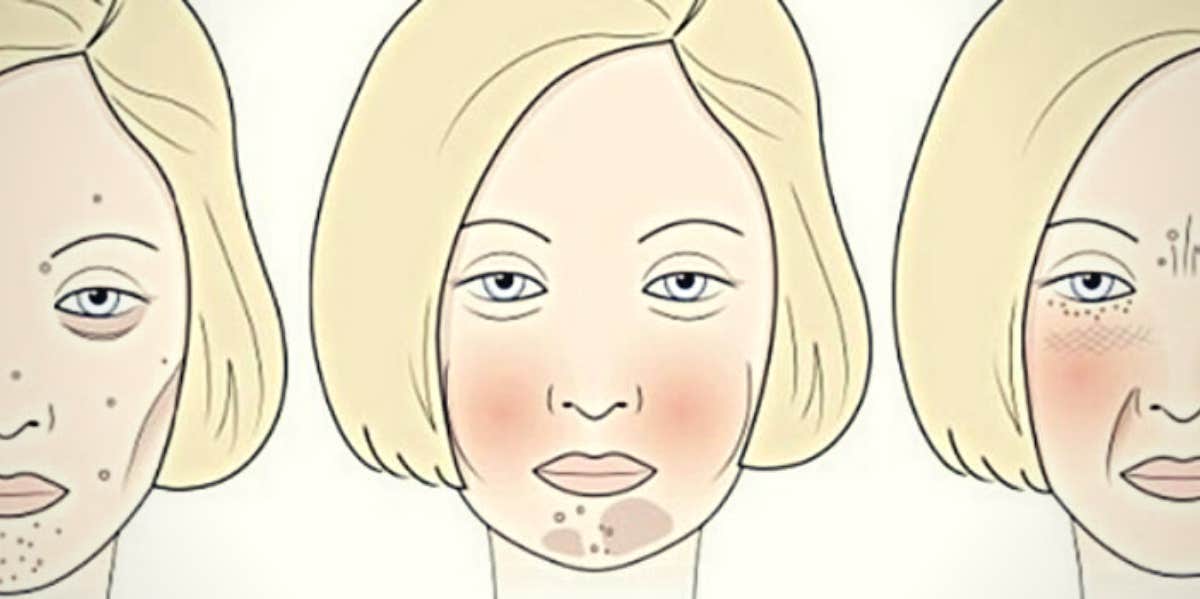How To Know If You Have A Sugar, Gluten, Dairy Or Wine Face (According To A Naturopathic Doctor)
Changing what you eat can affect your skin.
 Dr. Nigma Talib
Dr. Nigma Talib What we eat or drink affects our whole body in both positive and negative ways. We know that if we eat a healthy diet featuring leafy green vegetables, we're going to feel good. And we also know that if we consume an entire box of chocolates, we're going to feel like crap.
But how does consuming certain things like sugar, dairy, gluten, and wine affect our faces? Based on science, you can discover what type of face you have.
Dr. Nigma Talib, ND is a naturopathic doctor. A naturopathic doctor focuses on holistic, proactive prevention and comprehensive diagnosis and treatment.
Dr. Talib worked out why we suffer from common skin problems like acne, dark circles under our eyes, and redness. And it turns out, it's because of what we put into our bodies.
Dr. Talib believes that many skin problems on the face are due to sugar, wine, dairy, and gluten.
If you can identify what type of face you have and what's causing your problems, you can know what to eliminate from your diet.
Sugar face
Symptoms:
Forehead lines and wrinkles, under-eye sagging, pimples across face, cystic acne,thinner skin, dark gray or pale hue to the face.
Why does sugar change your face?
Too much sugar can make the elastic and flexible collagen fibers in our skin become rigid and tight and can increase our insulin levels, making the face look washed out and pasty.
Since sugar also affects the balance of bacteria in our bodies, this leads to breakouts on the face, shoulders, and chest. Sugar (via insulin levels) also thins eyebrow hair, making them look sparse.
Dairy face
Symptoms:
Puffy eyelids, darkness and bags under the eyes, acne and blemishes all over the face, pale cheeks, and chin pimples.
Why does dairy change your face:
Even if you don't consider yourself lactose intolerant, you could be anyway.
As we get older, we lose the enzymes that help us to digest lactose effectively and this can cause our immune system to release inflammatory chemicals.

Wine face
Symptoms:
Pronounced lines or acne between the eyebrows, droopy eyelids, fine lines and wrinkles underneath the eyes, dehydrated skin with feathery lines across the cheeks, enlarged pores, a reddish skin tone, and deep nasolabial folds.
Why does wine change your face?
Unfortunately, as good as wine may be for your heart, too much of it can dehydrate the skin, worsening the look of any fine lines and wrinkles, even those between the brows. In addition, wine can make capillaries dilate, causing flushed cheeks and a reddish complexion.
Don't forget that there's sugar in wine, so wine face also has the collagen issues of enlarged pores and droopy eyelids. If all that hasn't aged you enough, wine consumption gives you very deep nasolabial folds.
Gluten face
Symptoms:
Forehead acne, puffy cheeks and jowls, and a bloated face, cheek redness and/or red spots, as well as acne or dark patches on your chin.
Why does gluten change your face?
Make sure your waiter takes away that bread basket because the effects of gluten on your skin aren't pretty. When you have gluten, this can trigger an inflammatory response and leave your face looking bloated, inflamed, and/or swollen.
Gluten can also affect the pigmentation of the skin, leading to age spots and dark patches. Gluten can also affect the reproductive balance in the body and give you hormonal pimples on your chin.

If you've experienced these types of reactions to gluten, wine, sugar, dairy or a combination of them, the best thing to do is cut out the substances from your diet for at least 28 days to see if your skin and overall health improves. If it does, cut it out from your diet permanently, or most of the time. You'll feel and look much better.
Christine Schoenwald is a writer focused on relationships, psychology, and wellness. She's published in The Los Angeles Times, Salon, Woman's Day, Bustle.

